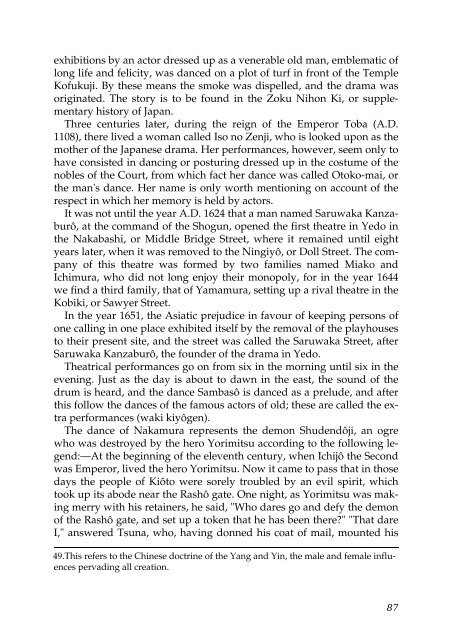You also want an ePaper? Increase the reach of your titles
YUMPU automatically turns print PDFs into web optimized ePapers that Google loves.
exhibitions by an actor dressed up as a venerable old man, emblematic <strong>of</strong><br />
long life and felicity, was danced on a plot <strong>of</strong> turf in front <strong>of</strong> the Temple<br />
K<strong>of</strong>ukuji. By these means the smoke was dispelled, and the drama was<br />
originated. The story is to be found in the Zoku Nihon Ki, or supplementary<br />
history <strong>of</strong> <strong>Japan</strong>.<br />
Three centuries later, during the reign <strong>of</strong> the Emperor Toba (A.D.<br />
1108), there lived a woman called Iso no Zenji, who is looked upon as the<br />
mother <strong>of</strong> the <strong>Japan</strong>ese drama. Her performances, however, seem only to<br />
have consisted in dancing or posturing dressed up in the costume <strong>of</strong> the<br />
nobles <strong>of</strong> the Court, from which fact her dance was called Otoko-mai, or<br />
the man's dance. Her name is only worth mentioning on account <strong>of</strong> the<br />
respect in which her memory is held by actors.<br />
<strong>It</strong> was not until the year A.D. 1624 that a man named Saruwaka Kanzaburô,<br />
at the command <strong>of</strong> the Shogun, opened the first theatre in Yedo in<br />
the Nakabashi, or Middle Bridge Street, where it remained until eight<br />
years later, when it was removed to the Ningiyô, or Doll Street. The company<br />
<strong>of</strong> this theatre was formed by two families named Miako and<br />
Ichimura, who did not long enjoy their monopoly, for in the year 1644<br />
we find a third family, that <strong>of</strong> Yamamura, setting up a rival theatre in the<br />
Kobiki, or Sawyer Street.<br />
In the year 1651, the Asiatic prejudice in favour <strong>of</strong> keeping persons <strong>of</strong><br />
one calling in one place exhibited itself by the removal <strong>of</strong> the playhouses<br />
to their present site, and the street was called the Saruwaka Street, after<br />
Saruwaka Kanzaburô, the founder <strong>of</strong> the drama in Yedo.<br />
Theatrical performances go on from six in the morning until six in the<br />
evening. Just as the day is about to dawn in the east, the sound <strong>of</strong> the<br />
drum is heard, and the dance Sambasô is danced as a prelude, and after<br />
this follow the dances <strong>of</strong> the famous actors <strong>of</strong> old; these are called the extra<br />
performances (waki kiyôgen).<br />
The dance <strong>of</strong> Nakamura represents the demon Shudendôji, an ogre<br />
who was destroyed by the hero Yorimitsu according to the following legend:—At<br />
the beginning <strong>of</strong> the eleventh century, when Ichijô the Second<br />
was Emperor, lived the hero Yorimitsu. Now it came to pass that in those<br />
days the people <strong>of</strong> Kiôto were sorely troubled by an evil spirit, which<br />
took up its abode near the Rashô gate. One night, as Yorimitsu was making<br />
merry with his retainers, he said, "Who dares go and defy the demon<br />
<strong>of</strong> the Rashô gate, and set up a token that he has been there?" "That dare<br />
I," answered Tsuna, who, having donned his coat <strong>of</strong> mail, mounted his<br />
49.This refers to the Chinese doctrine <strong>of</strong> the Yang and Yin, the male and female influences<br />
pervading all creation.<br />
87



